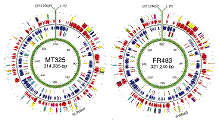Virology, Nebraska Center for
Document Type
Article
Date of this Version
7-19-2023
Citation
Scientific Reports | (2023) 13:11657 | https://doi.org/10.1038/s41598-023-38544-5
Abstract
SARS-CoV-2 belongs to the family Coronaviridae which includes multiple human pathogens that have an outsized impact on aging populations. As a novel human pathogen, SARS-CoV-2 is undergoing continuous adaptation to this new host species and there is evidence of this throughout the scientific and public literature. However, most investigations of SARS-CoV-2 evolution have focused on largescale collections of data across diverse populations and/or living environments. Here we investigate SARS-CoV-2 evolution in epidemiologically linked individuals within a single outbreak at a skilled nursing facility beginning with initial introduction of the pathogen. The data demonstrate that SARSCoV- 2 was introduced to the facility multiple times without establishing an interfacility transmission chain, followed by a single introduction that infected many individuals within a week. This largescale introduction by a single genotype then persisted in the facility. SARS-CoV-2 sequences were investigated at both the consensus and intra-host variation levels. Understanding the variability in SARS-CoV-2 during transmission chains will assist in understanding the spread of this disease and can ultimately inform best practices for mitigation strategies.
Included in
Biological Phenomena, Cell Phenomena, and Immunity Commons, Cell and Developmental Biology Commons, Genetics and Genomics Commons, Infectious Disease Commons, Medical Immunology Commons, Medical Pathology Commons, Virology Commons


Comments
Open access.